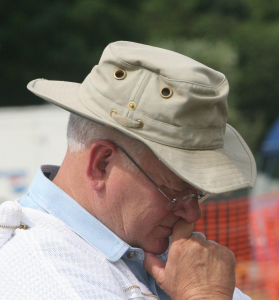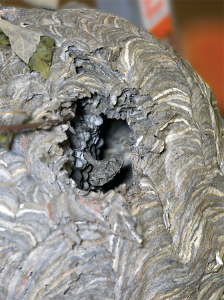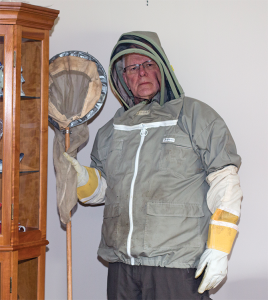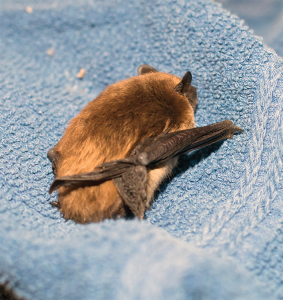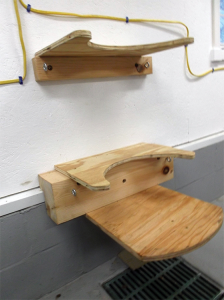You may not want to hear this, but beekeeping is changing (and that’s a good thing). Alternative uses for protective bee gear. Odds and Ends – a wall-mounted extractor stand.
By: JAMES E. TEW
I know some of you don’t want to read this…
You don’t have to be a great visionary to see some of the change is already upon today’s beekeeping enterprises – again. Beekeeping has changed many times before this occurrence.
For instance, only a few equipment producers are manufacturing all the components to wire and install foundation into wooden frames. In another old beekeeping area, I feel sappy when I write that the equipment to produce basswood sections (for comb honey) is only manufactured by one remaining company. Entire books have been written about producing comb honey. Many black and white apiary photos from the 20s and 30s show section supers on the colonies. This was a common procedure. Not only have we essentially lost the ability and the equipment to produce comb honey, but we have lost the consumer who knows how to eat comb honey. (It’s not difficult. You just chew wax and honey and swallow. It’s that easy.)
My Uncle Auby introduced my brother and me to beekeeping in the early 70s. He was the eccentric member of our extended family. Due to a polio affliction, he became a watch and clock repairman. In fact, I have his watchmakers lathe – it’s just as small as you would expect. He was into absolute precision.
To that precision end, in order to wire and embed the wire in the foundation dead straight, he re-drilled the predrilled eyelet holes in the ends of wooden frames. In articles past, I have told you all of this. Presently such holes are still bored in wooden frame end bars, but who of you use them? If you remember eyelet installation and wiring/embedding procedure, you have been in beekeeping a very long time. (If you do wire and embed foundation, why? I’d like to hear from some of you.)
All of this wiring procedure evolved to become Dadant’s Duragilt and Duracomb foundation. This was essentially a plastic sheet, coated with beeswax that was embossed with worker cell bases. This foundation was, essentially, the granddad of today’s foundation inserts. Roughly, during the 60s and 70s, Kelley Bee Supply manufactured a full line of plastic equipment – not expanded plastic foam – but heavy plastic hive components. Examples of this style of hive equipment still turns up at various auctions where old stuff once again comes to light. It’s not rare, but neither is it common. If you used these hive components, you have been in beekeeping a long time.
Today, beekeepers use either plastic frames (variations of which go back to the previous category) or plastic foundation inserts. The inclusion and acceptance of “inserts” as a beekeeping term got by me. I don’t know when it happened. Indeed, I was probably one of the last to stop calling this product foundation and make the move to call modern foundation inserts. Many of us are now in a hybrid phase. Rather than use all-plastic frames, we use wooden frames (frames that can be purchased already assembled) with foundation inserts.
While not an endorsement, I use this hybrid system – mainly because I have so many wooden frames. Wooden frames go back for eons in beekeeping use while the foundation inserts are reasonably recent. If you are comfortable using some form of dense foam hive equipment and you use either plastic frames or plastic foundation inserts, you are probably a bit youngish in beekeeping. You have been in beekeeping a few years – maybe a decade.
Beekeeping Internet pages, smartphone cameras, and webinars are commonplace for you. You don’t even think about their use. Not me – every time I snap a pic with my phone (my phone – mind you) I marvel at the device that can capture such a HD photo. (Why is this smart device still referred to as a phone – I rarely use it for talking.)
I, and beekeepers like me, have far too much time invested in the first two categories of ancient beekeeping procedures to fully embrace today’s procedures as common place without some reflection. We are now the ones who wander around at meetings, elbow crooked holding a half empty coffee cup and boring people with how it once was in beekeeping. It’s our right. It will be your right soon enough. Here’s the rub – I do not want to go back to old bee times. I love the gadgets and the amazing array of equipment that we use in everyday bee life.
I ask you to be patient – I’m trying to get somewhere with this thread.
Several years ago, Editor Kim hooked me up with a book publishing company. Due to that connection, I authored two books. My idea of what an author should be came from TV shows. Successful authors would have books in glass store fronts and participate in book signing sessions with long adoring lines of readers waiting for that rare autographed copy. Then came the follow-up books. My author image was all so grand. “He’s written a book!”
In my case, the book author was rather inconsequential. If I didn’t work out, the publishing company would simply find another bee guy and get him/her to put down bee words and comments. That reduced author position really did not fit my perception. My books required editors – who essentially rewrote most of the book (to make it fit a wider audience). It required designers, commercial artists, layout people and marketing people. It even required translators. I became just one of the component parts of the contract book publishing procedure. I learned a lot – especially about deadlines – but my ideal concept of a regal author has been changed forever. Would I write again – sure – but my eyes would be fully open next time.
Am I off the subject?
I don’t think so. I conjecture that the upcoming new age beekeepers will be more like a current day contract author rather than an old fashioned, hands-on, in the hive beekeeper. Actually, plumbing the depths of a functional hive will increasingly be a small part of what the keeper does. The beekeeping ability of this upcoming new-style of beekeeper will be based on electronic abilities rather than beekeeping ability. This near-future keeper will be able to use his/her Nest-based real-time video cam to check the bees.
Voluminous amounts of beekeeping info are on the web – video and written. Wi-Fi in the apiary is already here. (My yard will be on-line next season.) Video? Everyone with a smart phone is now a videographer. Don’t send an email. Send a video. In the late 1990s, that idea would have been 100% laughable. Only professionals with professional equipment could produce videos. Electronic hive heaters. Electronic Wi-Fi connected hive weighing devices. This equipment is essentially already here. Wi-Fi electronic hive labeling for theft prevention is in the apiary as I write this.
Why write something that does not need writing – but here it is. I cannot see the future. Twenty years ago, I would have foreseen NONE of what I just described above. Here’s the second rub – I suspect the reasonably near-future beekeeper will be even more electronically evolved than I could expect. I just have to believe that devices like pheromone sensing systems will be here. Check your smart phone if you want to know that the queen is still functioning within your electronic-based hive. Hives need supering? (The electronic weight device will tell you.) Go drain some honey out. In this near future scenario, the device(s) manage the bees. You manage the devices.
None of this future is unique to beekeeping. Agriculture is already leading the way in many regards. Cars are already driving themselves. Beekeeping is just caught up in the electronic changes. The era of the Smart Hive is upon us.
I confess . . .
I confess that this is not where I thought this piece would end. But I am amused by a thought I just had. By the time today’s modern beekeepers are nearing the average age of 70, with crooked elbows and a half cup of coffee, they will be telling electronic-age beekeepers who are managing their Smart Hives using some electronic gadget that, in their day, they actually had to suit up with grungy protective gear, go the apiary, light a smelly smoker, open the hive, and rummage through it to manually search for the queen. At that time, no one – not a single keeper will know how to embed wires into comb foundation nor how to make basswood honey sections. The components will not be available. Beekeeping must evolve to stay viable. This is a healthy thing for our bee industry, but we lose some things along the way.
Alternative uses for protective clothing
I have spent a lot of time in dirty, smoky-smelling, clumsy protective bee gear. I have a full wardrobe of these specialized clothes – so do you. As is often the case in beekeeping, necessary equipment has uses outside of beekeeping. A propane torch used to kill weeds can be used to singe the inside of diseased equipment. A leaf blower can be used to blow bees from supers. I use one of the new plastic package cages as a heat disperser between my amp and my computer that is running YouTube. The secondary use list would contain many, many listings. But the alternative is true. Protective clothing and other equipment can be used outside of beekeeping.
Jim, we have hornets that might sting our grandkids.
I’ve used my bee gear to remove hornet nests before. As you would expect, it works beautifully. The man inside the suit – me – is always skittish when wearing equipment to attack the beautiful nest.1
- While awaiting the decay odors to fade, critters, (possibley ground squirrels) opened the side of the nest.
- Anything look out of place here? Why would you ever think you could take a photo with that phone?
Suit up. Climb the ladder carrying a large plastic bag. Snip obstructing limbs and twigs. Don’t breathe on the nest – which is disconcertingly right in your face. Adroitly pull the bag over the nest. Hold the limb and bag top tightly with your left hand while using your right hand to cut the limb. (Of course, reverse all of this if you are left-hand dominant.) I must say that this is always a bit of a tense task for me. Hornets are not my “bees”, and I don’t feel that we have a special relationship. In my neighbor’s case, all worked beautifully, except…
I normally work from an 8’ ladder. I needed a 10’ for this project. While concentrating on holding the bag and holding onto the ladder, I momentarily forgot that I was not on my shorter ladder. I stepped off the ladder two steps too soon – and busted my rear. The whole way down – which – seemed like a 30 second fall, I admonished myself not to release my hold on that bag. My old body took a beating, but I held tight, and my protective gear worked flawlessly. From a safe distance, my wife asked if she should call 911? Was that comment funny or just plain logical?
Protecting against blackflies and other insects
This is an easy one – especially if you live in blackfly country. Those biting flies are miserable. A tight-meshed bee veil works well. Alternatively, a blackfly veil works well as a beekeeping veil. Years ago, when the flies were truly bad, I wore most of a full suit. These pesky insects seemed to get in anywhere. Gloves should not have gauntlets. The flies can get through.
Different insects, but the suit will also protect against mosquitoes. During Ohio mosquito season, I will use a veil for protection against them – especially at night. I had another neighbor who routinely borrowed a bee veil to wear while mowing his lawn. He had several yellowjacket nests and was allergic to their stings. He always brought it back and thanked me properly.
My most recent favorite – bat control
I know, I know. Many of you are old hat at removing bats that have gotten into your house. Indeed, I have several stories about friends with old, stately Ohio houses who had to routinely deal with them. Amusing stories they were, but they were not pertinent to me – until I got my own bat in the house. As it were, I wished I had listened more closely.
- JTew – Bat bee guy. The animal is just a bit beyond the edge of my bat net.
- My bat-proofed wife watching the proceedings.
- The little animal that caused such confusion.
My 1978 home has low ceilings for energy efficiency. I have no idea how the bat got in. It has never happened before. While watching brain-dead TV, my wife shouted that we had a bird in the house. This bird was flying at about 30 mph in a beautifully precise pattern just a few feet (remember – low ceilings) above our heads. No one was bored. Initially, I didn’t stand up, fearing a mid-air collision.
Poof – the animal was gone. Just that fast. Okay, now what Jim? I immediately thought, “I’m putting on my bee suit and my wife is, too.” We suited up and both of us immediately felt safer. I looked – as best I could – over the house for the reclusive animal. Nothing. I wanted to believe that it had found its way out. “Yeah, that’s what happened.” I opened my veil and took a break. My wife and I had time to gather our wits. Upon reflection, I had to admit that the bat was most likely still with us. I had to also realize that the animal would probably take flight when all the lights were turned off for the night. That would cause pandemonium. I had to search again.
Fairly quickly, I found the little furry, brown animal in a very narrow space behind a corner cabinet. I got out my old insect net, but it was not needed. With bee gloves on, I placed a towel over the hanging animal and took it outside. In an open outdoor shed, I opened the towel up, but the little animal seemed comatose. I left it there. An hour later, an inquisitive granddaughter, who had only recently arrived, wanted to have a look, but the bat was gone. I knew from other bat catchers that an Ohio agency wanted to check for rabies, but knowing some of you people would strenuously object, I released the animal unharmed2. The bee gear worked beautifully, and I felt confident while dealing with this huge, man-killer of an animal.
I know others have used bee equipment for bat control. How did it work? Anyone else used protective gear in non-traditional ways?
Odds and Ends
Mark Reifschneider sent me an interesting system he has developed that secures his small, motorized extractor to his shop wall. His shop walls are 2×6” on 16” centers.
- The wall brackets for the extractor.
- The extractor in place – minus the lower strap. Note the lower single leg.
He said, “The wall does not vibrate at all from the extractor. The extractor is a three large frame or six small frame extractor with a small motor to drive it.”
Mark added, “One other advantage to this type mounting is when you are done extracting and want to get the last bit of honey in the bottom of the extractor you just loosen the ratchet strap and tip the extractor forward with a block of wood and let it drain.”
Thank you.
Each time you get to this point, I feel a need to tell you that I appreciate your time spent in pawing your way through this monthly piece.
If you’re interested – I am tinkering again. I have posted some supporting audio comments for this article. It’s on Google Drive. As I become more accustomed to the procedure, I hope that my comments and dialogue will become more useful. If no one likes it, I will find something else to do with my articles.
1Please don’t come for me looking for blood on this subject of eradicating hornet nests. Neighbors are genuinely concerned for their family, and I help in order to keep them from complaining about my backyard honey bees visiting their property. Happily, another neighbor kept his hornet nest for the entire season – even frequently mowing directly beneath it. Neighbors are variable.
2Several years ago, I got a very public admonishment for mentioning killing skunks as a form of control in the apiary. An agitated participant was a skunk enthusiast. I am not writing anything untoward about skunk lovers. That’s the first time I found that some people can love nearly anything. I try to respect that.
 Long URL: https://drive.google.com/open?id=11-nP_JuilXKqZFMevaFPr0h1l5kdhlit
Long URL: https://drive.google.com/open?id=11-nP_JuilXKqZFMevaFPr0h1l5kdhlit
Shortened URL: https://tinyurl.com/Feb-2018-Art-icle-Audio
Dr. James E. Tew, State Specialist, Beekeeping, The Alabama Cooperative Extension System, Auburn University; Emeritus Faculty, The Ohio State University. Tewbee2@gmail.com; http://www.onetew.com; One Tew Bee RSS Feed (www.onetew.com/feed/); http://www.facebook.com/tewbee2; @onetewbee Youtube: https://www.youtube.com/user/onetewbee/videos





